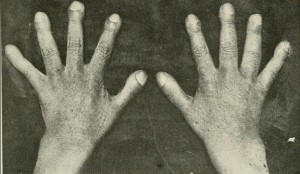by Jack El-Hai, Wonders & Marvels contributor
A few years ago, my teenage daughter announced that she had a malformation of her hands. “It’s called murderer’s thumb,” she said, producing the digits in question. I had previously noticed that that her thumbs were small and stubby with shortened nails, although I never considered that a malformation. But she told us that people with this thumb condition have banded together to start a community page on Facebook — perhaps encouraged by the news that the actress Megan Fox was a fellow member.
Murderer’s thumb — also called shovel thumb, toe thumb, Dutch thumb, hammer thumb, stub thumb, and potter’s thumb — goes by the medical appellation brachydactyly type D (BDD). It’s not terribly rare, appearing in around 0.4 percent of the population in the U.S., and in slightly higher frequencies in some other parts of the world. It’s an inherited trait that graces the thumbs of women more often than men.
BDD is completely harmless and even provides unexpected benefits in keyboard typing, video gaming, piano playing, and thumb-war battling. Some people, especially parents, find it cute.
In past centuries, though, the condition acquired a sinister reputation. The nineteenth-century European and American passion for categorizing racial groups and personal character through physical manifestations — physiognomy, craniometry, and phrenology are among these pseudo-scientific fields — branded the BDD thumb as a mark of primitive disposition, a sign of impulsive and unsophisticated thinking. Writers of popular detective novels sometimes scattered their stories with suspects with BDD to hint at criminal inclinations.
Palmists weigh in
In later decades, practitioners of palmistry took up the cause against BDD with even greater enthusiasm. Palm readers brought the term “murderer’s thumb” into the mainstream. In his 1901 manual The Laws of Scientific Hand Reading, William George Benham warns that clubbed thumbs are “dangerous companions…not to be trifled with at any time.” He further declares that “[m]any murderers have had clubbed thumbs…. Their brutal instincts being strong, jealousy most often has led them to fits of violent rage, and the terrible qualities of the clubbed thumb have given them passion and determination strong enough to take human life.”
Nine years later, the palmist Cheiro (a pseudonym of Louis Hamon) writes of people with murderer’s thumb: “If they are opposed they fly into ungovernable passions and blind rages. They have no control over themselves, and are liable to go to any extreme of violence or crime during one of their tempers.” Fortunately, says Cheiro, the owner of such a thumb cannot “plan out or premeditate a crime, for he would not have the determined Will or power of reason to think it out.”
As recently as 2011, in the book Practical Palmistry, Narayan Dutt Shrimal claims to have read the palms of 400 killers and “discovered that all had one common sign on their hands, that the murderer’s thumb was small and the tip of the thumb was flat, also that the nail of the thumb was small and more or less round in shape.”
Shrimal describes to perfection the thumbs of my daughter, who to the best of my knowledge has never killed in a fit of passion and years ago became a vegetarian out of compassion for the suffering of animals. Yet she is proud of her murderer’s thumbs.
Further reading:
Benham, William George. The Laws of Scientific Hand Reading. G.P. Putnam’s Sons, 1901.
Castriota-Scanderberg, Alessandro and Bruno Dallapiccola. Abnormal Skeletal Phenotypes: From Simple Signs to Complex Diagnoses. Springer, 2005.
Cheiro (Louis Hamon). Palmistry for All. G.P. Putnam’s Sons, 1910.

